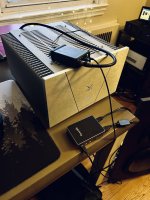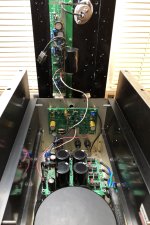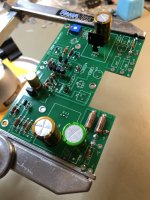Nice setup!Nice build Simon, the F4 amp is so neutral sounding it is timeless just change your preamp if you want a different sound. I have driven mine with Impass, Pumpkin, in balanced ( I have a pair of these) and XRK,s ASKA Lender single ended. All sounded great but different . One nice thing Mr Pass mentioned the F4 paired well with single driver speakers, I run the F4 in my office with the ASKA Lender and a pair of frugal horns and the sound stage just blows me away.
But... can an HP multifunction printer drive the F4?

What amp is this?I’m gonna give this a try. Spread the warmth.
Hello guys,
As the pictures are already uploaded in another thread and don't want to abuse the server uploading photos twice (yes, I use o be a nice guy), here the link.
https://www.diyaudio.com/community/threads/aleph-30-ps-advice.363391/
Thanks a lot!
As the pictures are already uploaded in another thread and don't want to abuse the server uploading photos twice (yes, I use o be a nice guy), here the link.
https://www.diyaudio.com/community/threads/aleph-30-ps-advice.363391/
Thanks a lot!
For those making DIY preamp cases , note how Altes used stainless steel hex cap screws threaded into hardwood .
Suggest #10 - 24 stainless hex cap screws . Drill the holes to the minor diameter , and then use a #10 - 24 tap to thread most of the way into the hardwood . For a DIY preamp case , you can mount a 1/4" thick aluminum face plate onto hardwood sides using this trick .
Make sure if you buy aluminum , the piece they give you isn't all scratched up .
Plus any exposed metal will need to be directly connected to Hydro Earth with its own dedicated machine screw .
If using this trick , suggest trying it on a practice piece first .
.
This is how I made it:
Before gluing up the case I attached the aluminum plate to the frontpanel with doublesided tape.
Then drilled all the holes for screws, pot and switches.
With the alu-plate off I inserted rivet-nuts for the 4 screws to fasten the the plate
to the wood. Coutersinking the wood to make place for all nuts on switches and pot.
Some holes in the alu-plate had to be enlarged to fit the pot and switches.
As for the back - drill all holes before assembling.
Works great for me.
Before gluing up the case I attached the aluminum plate to the frontpanel with doublesided tape.
Then drilled all the holes for screws, pot and switches.
With the alu-plate off I inserted rivet-nuts for the 4 screws to fasten the the plate
to the wood. Coutersinking the wood to make place for all nuts on switches and pot.
Some holes in the alu-plate had to be enlarged to fit the pot and switches.
As for the back - drill all holes before assembling.
Works great for me.
Not trying to be a know it all - which I'm certainly not - believe me ... but I just noticed one more technique you've used with your case .
The radial lines on the oak show that its quarter sawn ( cut from the center of the tree toward the bark )
The advantage of this cut is that it doesn't experience a type of warp called cupping .
Needless to say , a premium is paid for wood with this cut ... if it can be found .
Another option is mahogany which has one of the best tangential to radial warpage ratios .
Also , change my previous comment to #8 - 24 hex cap screws , #10 - 24's I mentioned above might be a bit big .
.
The radial lines on the oak show that its quarter sawn ( cut from the center of the tree toward the bark )
The advantage of this cut is that it doesn't experience a type of warp called cupping .
Needless to say , a premium is paid for wood with this cut ... if it can be found .
Another option is mahogany which has one of the best tangential to radial warpage ratios .
Also , change my previous comment to #8 - 24 hex cap screws , #10 - 24's I mentioned above might be a bit big .
.
The StaSIT....
The play on words, Stasis FE (with some alteration and mods) to drive SissySIT R.3's output stage. Not using the onboard buffer or signal transformer of SS R.3 here. FE feeds the coupling cap (C104 on the amp board) directly. This latest attempt keeps what I like about my previous experiments and discards some of the excess, some ideas that didn't quite work out, or could have been implemented better had I been more savvy. Stasis FE gets some tricks from FE '22... matched quad K170's, KSA992 VAS transistor, and the same RC filtering on power input for isolation from the amp rails. Gave it a bootstrapped VAS, you see these around sometimes but I haven't seen anyone use it here, unless I missed it. So, there it is... Some builders / listeners prefer this clever old fashioned VAS over the more common active CCS for SQ reasons. The Burning Amp #1 gain stage used one, as an example and provided some influence. I used a pair of 1.5K resistors and a 470uF cap, seen there on the bottom left of the PCB. Gain was set to 4X (+12db), same as the original amp value to pair well with my new high gain tube preamp. Sound impressions? Early days, need to complete the other channel to see what I've got here...
The play on words, Stasis FE (with some alteration and mods) to drive SissySIT R.3's output stage. Not using the onboard buffer or signal transformer of SS R.3 here. FE feeds the coupling cap (C104 on the amp board) directly. This latest attempt keeps what I like about my previous experiments and discards some of the excess, some ideas that didn't quite work out, or could have been implemented better had I been more savvy. Stasis FE gets some tricks from FE '22... matched quad K170's, KSA992 VAS transistor, and the same RC filtering on power input for isolation from the amp rails. Gave it a bootstrapped VAS, you see these around sometimes but I haven't seen anyone use it here, unless I missed it. So, there it is... Some builders / listeners prefer this clever old fashioned VAS over the more common active CCS for SQ reasons. The Burning Amp #1 gain stage used one, as an example and provided some influence. I used a pair of 1.5K resistors and a 470uF cap, seen there on the bottom left of the PCB. Gain was set to 4X (+12db), same as the original amp value to pair well with my new high gain tube preamp. Sound impressions? Early days, need to complete the other channel to see what I've got here...
Attachments
Last edited:
- Home
- Amplifiers
- Pass Labs
- Pictures of your diy Pass amplifier




